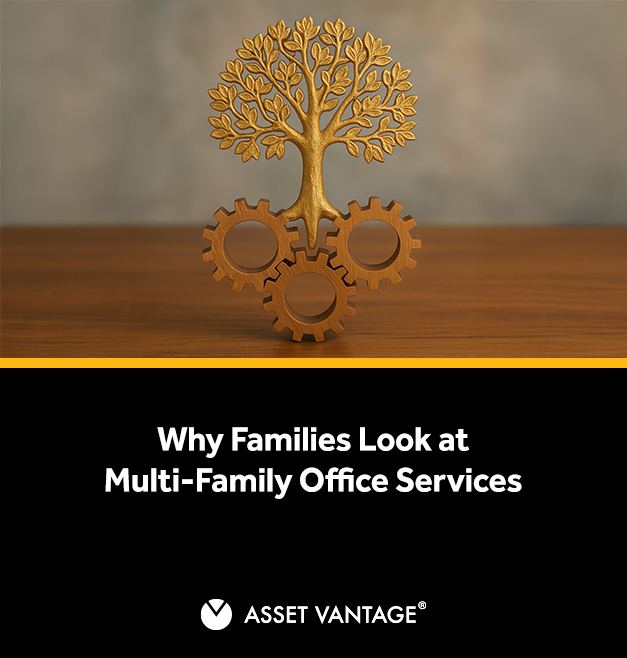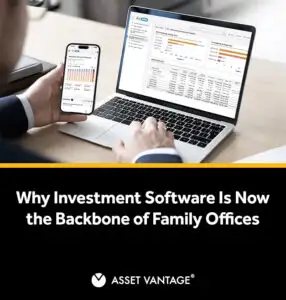For high-net-worth families that have outgrown private banks or wealth managers, a multi-family office provides not just investment advisory services, but a framework for protecting and growing family wealth across generations.
Finance and reporting form the foundation of multi-family office services.
Families turn to these offices when they need more than fragmented statements or product-driven advice from private banks. Multi-family offices consolidate oversight, ensuring that investment strategy, reporting, and governance work together under one structure.
Multi-family offices provide investment management, investment advice, and access to private equity, hedge funds, and bespoke investment strategies. Their role is not only to source investment opportunities but to balance them against each family’s values and risk tolerance.
A coordinated team of CPAs, wealth managers, and investment advisors oversees asset management. They align asset allocation and risk management with the family’s long-term investment strategy. This collaboration helps wealthy families maintain discipline across markets while adapting to changing opportunities.
Multi-family offices prepare consolidated financial statements and performance reporting that reflect the family’s financial assets as a whole. This reporting gives family members a clear view of wealth across accounts, jurisdictions, and asset classes. It supports informed decision-making and provides accuracy that single reports from private banks cannot match.
Preserving family wealth requires more than investment returns. Multi-family office services combine tax, estate, and succession expertise with governance structures that protect families across generations.
Advisors in multi-family offices provide tax planning that aligns with complex tax laws across jurisdictions. They design tax-efficient structures, implement strategies to minimize tax liabilities, and coordinate with money managers and financial advisors to ensure decisions remain compliant. A dedicated team delivers financial planning that integrates investments with reporting, offering services provided in ways that private banks rarely match.
Succession planning ensures that one family, or several families sharing a multi-family office, can transfer wealth without disruption. Estate strategies support continuity, reduce friction among family members, and balance personal needs with long-term investment philosophy. This work is central to wealth preservation and is a significant reason high-net-worth individuals turn to multi-family offices instead of wealth managers alone.
Successful families often want to align financial structures with values. Multi-family offices help client families shape their legacy planning, encompassing charitable giving, family governance, and educational opportunities for younger family members. These specific services preserve global wealth while ensuring future generations can carry forward both assets and values.
Strong governance is what separates multi-family office services from traditional wealth management. Instead of focusing only on investments, MFOs put in place structures that preserve harmony among family members and protect family wealth over decades.
Multi-family offices design governance frameworks that formalize how decisions are made, recorded, and reviewed. These structures reduce conflict among family members and create transparency. For other families considering whether to set up a single-family or multi-family office, clear governance is often the deciding factor.
MFOs establish internal controls that mirror enterprise-grade practices. Risk management frameworks cover financial oversight, cybersecurity, and operational continuity. Unlike wealth management services that center on portfolio returns, MFOs focus on the integrity of reporting, ensuring that the family’s wealth is shielded from structural and compliance risks.
Many multi-family offices establish family councils that involve younger family members in stewardship from an early age. These councils prepare the next generation for decision-making, align them with the family’s values, and build continuity. For successful families seeking wealth preservation, this preparation is just as necessary as asset allocation.
Multi-family office services extend beyond balance sheets. For high-net-worth families, managing household expenses, travel, and lifestyle commitments requires the same accuracy and discipline as financial reporting.
MFOs provide household accounting and bill pay that cover the family’s financial affairs daily. This includes:
Concierge services reflect the customized solutions that distinguish multi-family offices from private banks. Typical services provided include:
Unlike private banks, which offer lifestyle support as product add-ons, multi-family offices integrate these services into the broader framework of wealth management and financial planning. That integration is what preserves transparency and enables decision-making.
Families evaluating multi-family office services are usually weighing them against two familiar models: single-family offices on one end and wealth managers or private banks on the other. The trade-offs are as much about cost and scale as they are about governance and continuity.
Single-family offices provide maximum control. They employ a dedicated team that focuses exclusively on one family’s financial affairs, estate strategies, and lifestyle management. The trade-off is cost: a single-family office requires substantial global wealth and the ability to support an asset-based fee structure for specialized staff. Multi-family offices achieve cost efficiency by spreading infrastructure across multiple families while still providing customized solutions and governance structures.
Wealth managers and private banks excel at delivering investment opportunities and portfolio advice. They operate on a product-driven model, often tied to an investment philosophy or asset-based fee that incentivizes transaction flow. What they rarely provide are governance frameworks, consolidated financial reporting, tax and estate planning, or concierge services. Multi-family offices fill this gap by combining investment advisory with family governance, succession planning, and lifestyle oversight.
Multi-family office services become relevant when family wealth reaches a scale and complexity that cannot be managed effectively through wealth managers, private banks, or a single-family office built on limited resources. The decision often comes down to cost, governance, and scope.
Families should ask about the fee structure, services offered, and alignment with the family’s values. The best firms deliver a comprehensive financial services suite with cost savings and personalized service. Use this step-by-step guide to choose a multi-family office partner that aligns governance, reporting, and operations with your family’s values.
Define Scope and Priorities
The starting point is clarity on what the family needs. A strong partner must be able to deliver a comprehensive suite: financial planning, asset management, investment strategy, tax planning, risk management, succession planning, and lifestyle services such as concierge and bill pay. Families should assess today’s requirements while also anticipating the needs of younger family members who will inherit responsibility for decision-making in the future.
Match the Model to Complexity
Choosing between a single-family and a multi-family office often comes down to scale. A single-family office requires a dedicated team and significant capital. Multi-family offices provide cost efficiency by pooling resources across client families while still offering customized solutions and personalized service. For high-net-worth individuals with entities spread across multiple geographies, the shared model strikes a balance between infrastructure and flexibility.
Test Investment Alignment
A credible office should demonstrate how it builds and manages an investment strategy. Families need to understand whether oversight is handled in-house by money managers or coordinated through external wealth managers and financial advisors. They should ask how private equity, hedge funds, and other investment opportunities are evaluated and integrated, and whether these align with the family’s values and long-term objectives.
Review Reporting and Transparency
Consolidated reporting is one of the clearest indicators of quality. Multi-family offices should be able to provide timely, accurate financial statements that cover the family’s financial affairs across custodians and jurisdictions. Reporting should allow family members to see performance across asset classes and support informed decision-making. Successful families often preview live reporting packs during the evaluation process to judge how the office manages complexity.
Confirm Governance and Succession Planning
The right partner must be equipped to design governance frameworks and succession plans. Families should confirm there are documented structures for conflict resolution, decision making, and long-term stewardship. Leading firms also prepare younger family members by involving them in family councils and training programs that build competence over time.
Inspect Risk Management and Controls
Governance is incomplete without strong internal controls. Families should walk through the firm’s approach to approvals, vendor due diligence, and incident response. These systems protect family wealth from operational lapses and ensure continuity across generations.
Evaluate Lifestyle and Operating Services
Lifestyle services, such as concierge support and bill pay, often reveal whether the office integrates day-to-day operations with effective financial oversight. Families should examine how these services are approved, executed, and reconciled into consolidated reporting. Clear accountability in this area indicates that the office can manage more than just investments.
Assess the Team and Fee Structure
Families should meet the professionals who will manage their affairs daily, not only senior partners. Coverage ratios, continuity planning, and access to specialized services matter as much as reputation. Fee structures must be transparent and fair, with clear explanations of how charges scale with assets and services provided. The objective is alignment. Fees should be tied to service delivery and outcomes, not transaction volume.
Choosing the right multi-family office partner is less about glossy service menus and more about alignment. Scope, governance, reporting, and fee clarity are the filters that reveal whether a firm can manage complexity with discipline. Families that push for transparency early are the ones that secure continuity and protect family wealth across generations.
Multi-family office services exist to manage complexity. They integrate investment oversight, financial planning, governance, succession, and even daily operations into one framework. Families that outgrow private banks or wealth managers turn to this model because they want a comprehensive suite of services without the cost of a dedicated single-family office.
The choice is not simply about efficiency. It is about continuity. A well-chosen multi-family office partner aligns reporting, decision making, and lifestyle execution with the family’s values. That alignment is what preserves family wealth, strengthens governance, and prepares younger family members for leadership.
For successful families weighing their options, the trade-off is clear: private banks offer products, single-family offices offer control, but multi-family offices offer balance. They provide the infrastructure and discipline needed to protect assets, deliver transparency, and safeguard legacy across generations.







